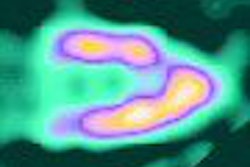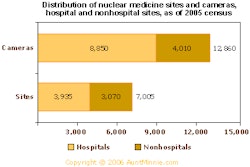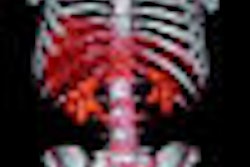Sure, multidetector-row CT can do arteries, but how about global and regional left ventricular (LV) function? It can indeed assess them accurately, researchers from the Netherlands reported in the European Journal of Nuclear Medicine and Molecular Imaging.
Global and regional LV function are important indicators of cardiac status in patients with coronary artery disease, affecting therapy and management decisions in important ways. LV function is used for risk stratification in coronary artery disease, for example. Cardiac MRI is the current gold standard modality for evaluating LV volumes and ejection fraction, but other methods are increasingly being used.
In patients with suspected coronary artery disease, correlations were good between gated SPECT and MDCT, and excellent between 2D echocardiography and MDCT, reported Drs. Maureen Henneman, Jeroen Bax, J. Wouter Jukema, and colleagues from Leiden University Medical Center in the Netherlands (European Journal of Nuclear Medicine and Molecular Imaging, July 25, 2006, e-publication before print).
"Multislice computed tomography has already earned its place as an imaging modality for noninvasive assessment of the coronary arteries, but since retrospective gating to the patient's ECG is performed, information on LV function can be derived," the group wrote. This enables the measurement of LV volumes and ejection fractions with MDCT, and the assessment of regional wall motion on short-axis images. However, its use has not been extensively validated in 16- and 64-slice MDCT scanners, the group wrote.
The study consecutively examined 49 patients (35 men, 14 women; mean age 62 ± 12 years) with known or suspected coronary artery disease who underwent scans with either 16-slice (n = 31, 16 x 0.5 mm, 500-600 mAs, 120 kVp) or 64-slice (n = 18, 64 x 0.5 mm, 300 mAs, 120 kVp) MDCT (Aquilion 16 or 64, Toshiba America Medical Systems, Tustin, CA).
An independent observer manually outlined endocardial borders on short-axis cine images, the group wrote. LV end-diastolic volume (LVEDV), LV end-systolic volume (LVESV), and LV ejection fraction (LVEF) were calculated with dedicated software, and two observers assessed wall motion visually using the short-axis slices.
Myocardial SPECT was performed with a triple-head SPECT camera (GCA 9300, Toshiba). As part of the clinical protocols, 2D echocardiography was performed, the authors wrote. Patients were imaged with a VingMed Vivid 7 scanner (GE Healthcare, Chalfont St. Giles, U.K.) using a 3.5-mHz transducer. LV volumes and ejection fractions were derived using the biplane Simpson's rule, and regional wall motion was assessed using the same 17-segment model as for SPECT and MDCT.
According to the results, "correlations were fairly good" between gated SPECT and MDCT (LVEDV: r = 0.65; LVESFV: r = 0.63; LVEF: r = 0.60), and "excellent" between 2D echocardiography and MDCT (LVEDV: r = 0.92; LVESF: r = 0.93; LVEF: r = 0.80), the authors wrote. "Agreement for regional wall motion was 95% (k = 0.66) between gated SPECT and (MDCT), and 96% (k=0.73) between 2D echocardiography and (MDCT)."
While several imaging modalities allow assessment of global and regional LV function and volumes, MDCT is fairly quick and simple to perform since it uses the same scan procedure as for CT coronary angiography, the authors wrote. This is fortunate inasmuch as CT's radiation burden is too high to justify LV volumes and regional function by themselves, they added.
Measurement reproducibility is excellent with MDCT, and although motion artifacts can blur the endocardial contours and make functional measurements less reliable. But, they noted, 64-slice CT reduces the entire scan to 10 seconds, a manageable breath-hold for almost all patients. MDCT can provide information on LV status in addition to the assessment of coronary arteries, so it is important to validate its measurements, the group wrote.
"Our results show that (MDCT) and 2D echocardiography correlated very well for the assessment of LVEDV, whereas the correlation with gated SPECT for this parameter was less strong," they wrote. "An explanation for this finding could be that a larger part of the LV outflow tract is visible on (MDCT) and 2D echocardiography, and is thus included in the LV analysis as compared with gated SPECT. It is possible that on gated SPECT this part of the LV will be underestimated owing to lower counts in the basal part of the system."
Gated SPECT is also known to be less accurate in small hearts, and the fact that 500 MBq of technetium-99m tetrofosmin and suboptimal collimation were used may have also contributed to this finding, they added.
In any case, the group wrote, their results correlate with a previous report by Yamamuro et al. In a study that assessed LVEF with eight-slice CT, gated SPECT, 2D echocardiography, and cardiac MRI, MDCT was more accurate than SPECT or echocardiography (Radiology, February 2005, Vol. 234:2, pp. 381-390).
The radiation burden of MDCT is certainly a limitation for assessing LV function alone though it does provide significant additional information. Also, no cardiac MR was performed, and the study population was small, they noted. Finally, both 16- and 64-slice CT were used, although comparison of Bland-Altman analyses between these two groups did not show a significant difference for any global or regional LV function parameters.
Global and regional LV functional and volumes assessment can be well performed with multidetector-row CT, the team concluded. "Correlations between gated SPECT and MDCT and 2D echocardiography are adequate to sufficiently evaluate cardiac function," they wrote.
By Eric Barnes
AuntMinnie.com staff writer
August 7, 2006
Related Reading
Cocaine use linked to left ventricular dysfunction, May 4, 2006
Ventricular dysfunction not enough to identify sudden cardiac death risk, March 28, 2006
PET, SPECT measures of LVEF have superior predictive value, March 13, 2006
CT nips at MRI's heels in LV function study, June 29, 2005
MDCT maybe equivalent to MRI, tops echo and SPECT for heart function, February 15, 2005
Copyright © 2006 AuntMinnie.com



















